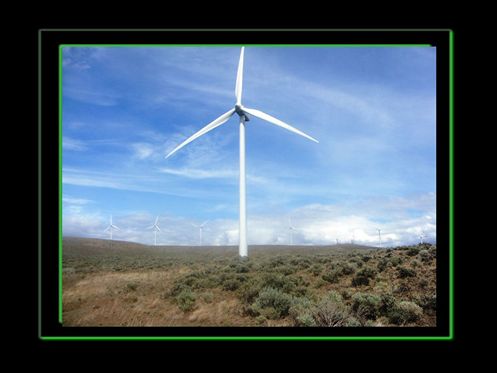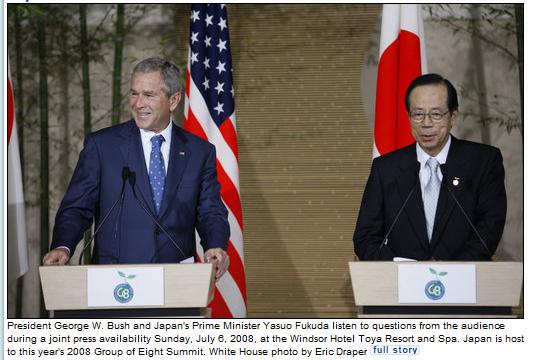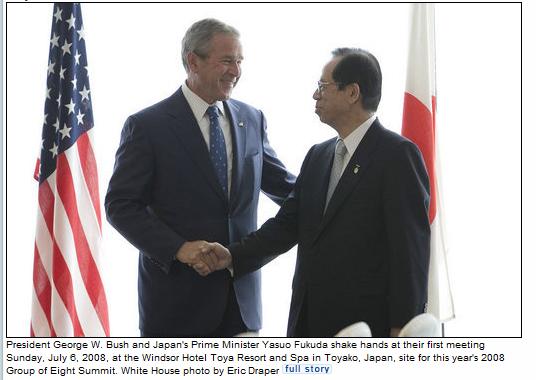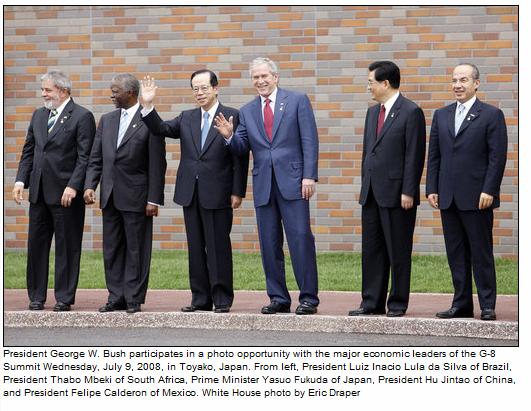|
The
following is the Fact Sheet: The Major Economies Leaders Meeting
Making Progress Toward A Future International Climate Change
Agreement
For
Immediate Release Office of the Press Secretary July 9,
2008
Today, 17 leaders of the Major Economies
held an unprecedented summit in Toyako, Japan, to advance
shared objectives of reducing greenhouse gas emissions,
contribute to ongoing negotiations under the UN Framework
Convention on Climate Change (UNFCCC), and identify actions
to be taken immediately. Leaders of Australia, Brazil, Canada,
China, the European Union, France, Germany, Indonesia, India,
Italy, Japan, Mexico, Republic of Korea, Russia, South Africa,
the United Kingdom, and the United States issued a Declaration
that:
 Acknowledges that the global challenges of climate change,
energy security, and sustainable development are interlinked;
Acknowledges that the global challenges of climate change,
energy security, and sustainable development are interlinked;
 Recognizes the leadership role of all Major Economies – developed
and developing – in combating climate change;
Recognizes the leadership role of all Major Economies – developed
and developing – in combating climate change;
 Highlights the value and contribution of the Major Economies
Meetings in supporting the UNFCCC, building confidence, and
elaborating on areas of shared understanding.
Highlights the value and contribution of the Major Economies
Meetings in supporting the UNFCCC, building confidence, and
elaborating on areas of shared understanding.
The
leaders' declaration emphasizes "ambitious, realistic, and achievable"
steps, stating that:
 It would be desirable for all countries to adopt an ambitious
long-term global goal for greenhouse gas emissions reduction
that assures growth and prosperity, recognizing that achieving
such a goal depends on significant advances in technology;
It would be desirable for all countries to adopt an ambitious
long-term global goal for greenhouse gas emissions reduction
that assures growth and prosperity, recognizing that achieving
such a goal depends on significant advances in technology;
 Developed Major Economies will take actions in the mid-term
to halt the growth of greenhouse gas emissions and achieve
absolute emission reductions, and developing major economies
will take actions in the mid-term to achieve a deviation from
business-as-usual emissions;
Developed Major Economies will take actions in the mid-term
to halt the growth of greenhouse gas emissions and achieve
absolute emission reductions, and developing major economies
will take actions in the mid-term to achieve a deviation from
business-as-usual emissions;
 Mid-term goals, commitments, and actions of all Major Economies
are to be reflected in the agreed outcome of the UNFCCC negotiations
to be concluded in December 2009; and
Mid-term goals, commitments, and actions of all Major Economies
are to be reflected in the agreed outcome of the UNFCCC negotiations
to be concluded in December 2009; and
 Actions to reduce net emissions from deforestation and forest
degradation can contribute to greenhouse gas stabilization.
Actions to reduce net emissions from deforestation and forest
degradation can contribute to greenhouse gas stabilization.
Leaders
agreed to take near-term actions, including:
 Working together on technology cooperation and cutting emissions
in specific economic sectors;
Working together on technology cooperation and cutting emissions
in specific economic sectors;
 Directing trade officials responsible for the WTO Doha negotiations
to advance with urgency their discussions on climate-related
issues, with an emphasis on eliminating trade barriers to
the spread of clean energy technologies;
Directing trade officials responsible for the WTO Doha negotiations
to advance with urgency their discussions on climate-related
issues, with an emphasis on eliminating trade barriers to
the spread of clean energy technologies;
 Accelerating technology development, transfer, financing,
capacity building and measurement methodologies to support
mitigation and adaptation efforts; and
Accelerating technology development, transfer, financing,
capacity building and measurement methodologies to support
mitigation and adaptation efforts; and
 Improving energy efficiency and promoting new, climate-beneficial
actions under the Montreal Protocol on Substances That Deplete
the Ozone Layer.
Improving energy efficiency and promoting new, climate-beneficial
actions under the Montreal Protocol on Substances That Deplete
the Ozone Layer.
Leaders agreed to continue to work together to promote the success
of the Copenhagen Climate Change Conference in December 2009,
when the UN negotiations launched in December 2007 in Bali,
Indonesia, are set to conclude.
Background
Since
President Bush launched the Major Economies process in May 2007
there has been growing international agreement that, to be effective,
a global framework will require commitments from all Major Economies
– both industrialized and emerging – to take actions to reduce
emissions. There is now broad acknowledgement that all Major
Economies must contribute to solving the problem, recognizing
that what steps each Major Economy takes will differ according
to its national circumstances.
 Each of the Major Economies is developing and implementing
national goals and plans to reduce greenhouse gas emissions.
America's national plan is a comprehensive blend of mandates,
incentives, public-private partnerships, and technology programs
to reduce emissions by increased investment in clean and efficient
energy technologies.
Each of the Major Economies is developing and implementing
national goals and plans to reduce greenhouse gas emissions.
America's national plan is a comprehensive blend of mandates,
incentives, public-private partnerships, and technology programs
to reduce emissions by increased investment in clean and efficient
energy technologies.
 Sectoral approaches can support national climate change efforts,
as demonstrated by the Asia-Pacific Partnership on Clean Development
and Climate (APP). The APP facilitates investment in clean
technologies and accelerates the sharing of energy efficient
practices among seven of the Major Economies in the region
– with a particular focus on China and India.
Sectoral approaches can support national climate change efforts,
as demonstrated by the Asia-Pacific Partnership on Clean Development
and Climate (APP). The APP facilitates investment in clean
technologies and accelerates the sharing of energy efficient
practices among seven of the Major Economies in the region
– with a particular focus on China and India.
The
U.S. Is Taking Action To Confront Climate Change And Strengthen
America's Energy Security.
The most recent UN data shows that, since President Bush took
office, U.S. results in reducing net greenhouse gas emissions
were second best among the Major Economies.
In
April, President Bush announced a new national goal to stop
the growth in U.S. greenhouse gas emissions by 2025. This new
goal marks a major step forward in America's ongoing efforts
to address climate change. As we continue to fully implement
strong new laws, provide appropriate incentives, and adhere
to the principles the President outlined for future programs,
the United States will continue on an ambitious new track for
greenhouse gas reductions. The growth in emissions will slow
over the next decade, stop by 2025, and begin to reverse thereafter,
so long as technology continues to advance. Our landmark actions
will prevent billions of metric tons of greenhouse gas emissions
from entering the atmosphere.
Record
Funding for Climate-Related Science, Technology, and Incentive
Programs: Since 2001, the President has devoted approximately
$45 billion for climate-related science, technology, observations,
international assistance, and tax incentive programs. Annual
funding for technology R&D currently exceeds $4 billion. The
United States has $42.5 billion in loan guarantee authority
available for technologies that avoid, reduce, or sequester
greenhouse gases or air pollutants, including nuclear, large-scale
renewables, and clean coal technologies. Our farmers now can
compete for billions of dollars in conservation incentives to
sequester carbon dioxide.
Improving
Fuel Economy, Use of Renewable Fuels, and Energy Efficiency:
Congress passed and the President signed last December energy
legislation that responds to the President's "Twenty in Ten"
challenge to improve vehicle fuel economy and increase alternative
fuels. The Renewable Fuels Standard will increase the use of
renewable fuels by more than 500 percent – requiring fuel producers
to supply at least 36 billion gallons of renewable fuel in the
year 2022. The Vehicle Fuel Economy Mandate specifies a national
mandatory fuel economy standard of 35 miles per gallon by 2020,
which will save billions of gallons of fuel and increase efficiency
by 40 percent. Additionally, the legislation establishes mandatory
programs for efficiency of lighting, appliances, and Federal
government operations.
Broad Range of Domestic Partnerships and Incentives: The President
launched a comprehensive portfolio of domestic initiatives to
develop new technologies through dozens of voluntary, incentive-based,
and mandatory programs. These programs include Climate VISION,
Climate Leaders, SmartWay Transportation Program, and the Hydrogen
Fuel Initiative. The United States is a world leader in advancing
a broad range of technology needs, including fusion, hydrogen,
nuclear, plug-in vehicles, batteries, biofuels, low-carbon coal
power generation, large-scale renewable power, and electricity
transmission.
#
#
#
It
is the 34th anniversary for G8 Summit. During the G8 summit
in Toyako, G8 Major Leaders discussed to set a five-year deadline
to commit US$60 billion in funding to help fight disease in
Africa and renewed a commitment made three years earlier to
double aid for Africa to $25-billion by 2010 and to consider
pledging further assistance after 2010. (4)
G8
summits took the place to host by Japan include: Tokyo in 1979,
1986, 1993; and Nago, Okinawa in year 2000. It is the
heads of the richest industrialized countries: France, Germany,
Italy, Japan, the United Kingdom, the United States, Canada
(since 1976), Russia (since 1998), and the President of the
European Commission (since 1981).
G8
Summit the world leaders discussed the global warming issue,
the G8 leaders agreed on the need for the world to cut carbon
emissions blamed for global warming by at least 50 percent by
2050 which reminds of me that the Boeing Company has been studied
and took the place to have the new air traffic management concept
and applys regulations environmental laws include the company
policies and procedures in order to cut the fuel consumption
and CO2 emmisions. The Boeing is committed to promotes environmental
stewardship. The Boeing will Prevent the pollution by conserving
energy and resources, recycling, reducing waste and pursuing
other source reduction strategies. Continually improve the environmental
management system. (4) (2)
G8
summit 2008, the world leaders working together to support the
world food crisis,
and to have the safety, secure environment and Climate Change.
Changing
to clean environment is the most critical issue on earth now
and it is becoming the major issues. According to Big TV: Marcus
Morrell, Camera and Editor - Marcus Morrell interview says that
the challenge that lies before us is to stabilize greenhouse
gas emissions within the next 10-15 years. We must then reduce
emissions globally if we are to avoid runaway climatic change
(6).
The
Washington State has been took this seriously, one of the example
like with the issue of climate protection hotter than ever and
the impacts of climate disruption widely felt in the Seattle
region and beyond, Seattle’s Climate Action Plan is a robust
call to action for the entire community. In February, 2005,
Mayor Nickels issued the “Kyoto Challenge,” a national effort
to tackle climate disruption and implement the Kyoto Protocol
in cities across the United States. With hundreds of mayors
across the United States now participating, the U.S. Mayors
Climate Protection Agreement continues to gain support. (7)
Seattle,
Washington is continue to pursue A “greenprint” for a climate-friendly
Seattle, the plan calls for new climate protection investments,
the formation of diverse and strategic partnerships -- like
the Seattle Climate Partnership -- and action from businesses,
government and citizens.
The
renewable energy provide clean environment. The world seems
coming to the point: must use the renewable energy that energy
generats from natural resources—such as sunlight, wind, rain,
tides and geothermal heat—which are renewable (naturally replenished).
Renewable
energy technologies range from solar power, wind power, hydroelectricity/micro
hydro, biomass and biofuels for transportation. Here are more
renewalbe power that can produce: Ethanol, Geothermal, Ocean
(tidal) power, Wave power, and wind power.(4)

THE
PUGET SOUND WIND TURBINES - Wild Horse
PHOTO BY: Sandra Englund
| Renewable
Energy |
| Biofuels |
| Biomass |
| Hydro
power |
| Solar
power |
| Tidal
power |
| Wave
power |
| Wind
power |
It
is positive to see that the world is taking the serious on this
climate protection commitment and developing the solutions to
global climate disruption and beginning development of a Climate
Action Plan. The community appreciates the G8 world leaders
taking in charge of this serious matter around the world.
G8
SUMMIT 2008 LINKS:
July
6, 2008 President
Bush Participates in Joint Press Availability with Prime Minister
Fukuda of Japan.
July 7, 2008 President
Bush Meets with President Medvedev of Russia at G8 Summit
July 8, 2008 President
Bush Meets with Chancellor Merkel of Germany at G8 Summit
July 9, 2008 President
Bush Pleased by Passage of FISA Reform Legislation
Other
Links:
1)
Boeing Environment
2)
OPTO Clearner
3)
Yahoo.com
4)
wikipedia
5)
Climate feed back
6)
Facing Consequences
7)
Seattle Climate Action Plan.
Reported
by : Catch4all.com, Sandra Englund, revised July 10th, 2008.
|






